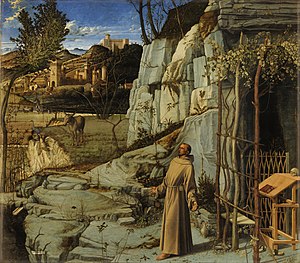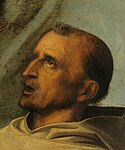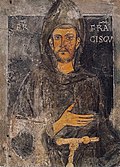
Giovanni di Pietro di Bernardone, known as Francis of Assisi, was an Italian mystic, poet and Catholic friar who founded the religious order of the Franciscans. He was inspired to lead a Christian life of poverty as a beggar and itinerant preacher. One of the most venerated figures in Christianity, Francis was canonized by Pope Gregory IX on 16 July 1228. He is commonly portrayed wearing a brown habit with a rope tied around his waist, featuring three knots that symbolize the three Franciscan vows of poverty, chastity, and obedience.
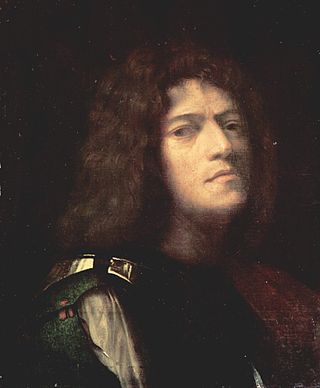
Giorgione was an Italian painter of the Venetian school during the High Renaissance, who died in his thirties. He is known for the elusive poetic quality of his work, though only about six surviving paintings are firmly attributed to him. The uncertainty surrounding the identity and meaning of his work has made Giorgione one of the most mysterious figures in European art.

Giovanni Bellini was an Italian Renaissance painter, probably the best known of the Bellini family of Venetian painters. He was raised in the household of Jacopo Bellini, formerly thought to have been his father, but now that familial generational relationship is questioned. An older brother, Gentile Bellini was more highly regarded than Giovanni during his lifetime, but the reverse is true today. His brother-in-law was Andrea Mantegna.
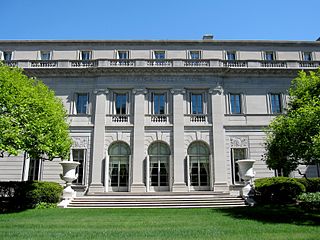
The Frick Collection is an art museum in New York City. Its permanent collection features Old Master paintings and European fine and decorative arts, including works by Bellini, Fragonard, Goya, Holbein, Rembrandt, Titian, Turner, Velázquez, Vermeer, Thomas Gainsborough, and many others. The museum was founded by the industrialist Henry Clay Frick (1849–1919), and its collection has more than doubled in size since opening to the public in 1935. The Frick also houses the Frick Art Reference Library, a premier art history research center established in 1920 by Helen Clay Frick (1888–1984).

BartolomeoMontagna was an Italian Renaissance painter who mainly worked in Vicenza. He also produced works in Venice, Verona, and Padua. He is most famous for his many Madonnas and his works are known for their soft figures and depiction of eccentric marble architecture. He is considered to be heavily influenced by Giovanni Bellini, in whose workshop he might have worked around 1470. Benedetto Montagna, a productive engraver, was his son and pupil and active until about 1540. He was mentioned in Vasari's Lives as a student of Andrea Mantegna but this is widely contested by art historians.
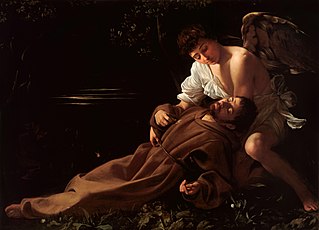
Saint Francis of Assisi in Ecstasy is a painting by the Italian Baroque master Michelangelo Merisi da Caravaggio. It is now in the Wadsworth Atheneum, Hartford, Connecticut.
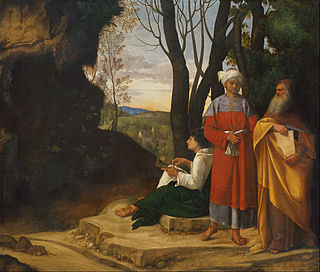
Italic text

The Hermit Saints is a religious oil on panel painting displayed as a triptych, meaning it is one whole painting composed of three separate scenes. This artwork was made by the Renaissance artist Hieronymus Bosch, dating from 1493. The entirety of the triptych painting measures 86 by 60 centimetres. This artwork is currently being housed at the Gallerie dell'Accademia, Venice.
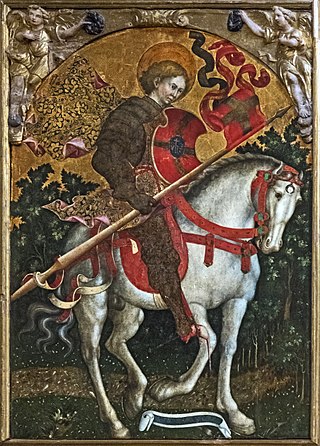
Michele Taddeo di Giovanni Bono, known as Giambono was an Italian painter, whose work reflected the International Gothic style with a Venetian influence. He designed the mosaics of the Birth of the Virgin and Presentation in the Temple. His best known paintings are the Man of Sorrows and the St. Peter.

Saint Francis Receiving the Stigmata is a panel painting in tempera by the Italian artist Giotto, painted around 1295–1300 for the Church of Saint Francis in Pisa and it is now in the Musée du Louvre in Paris. It shows an episode from the life of Saint Francis of Assisi, and is 314 cm high by 162 cm wide. It is signed OPUS IOCTI FLORENTINI.

Saint Francis of Assisi Receiving the Stigmata is the name given to two unsigned paintings completed around 1428–1432 that art historians usually attribute to the Flemish artist Jan van Eyck. The panels are nearly identical, apart from a considerable difference in size. Both are small paintings: the larger measures 29.3 cm x 33.4 cm and is in the Sabauda Gallery in Turin, Italy; the smaller panel is 12.7 cm x 14.6 cm and in the Philadelphia Museum of Art. The earliest documentary evidence is in the 1470 inventory of Anselm Adornes of Bruges's will; he may have owned both panels.

Among the paintings attributed to Giovanni da Rimini are two panels from a former diptych, dated to 1300–1305, of which the left wing is in the collection of the National Gallery, London, and the right that of the Galleria Nazionale d'Arte Antica, Palazzo Barberini, Rome.
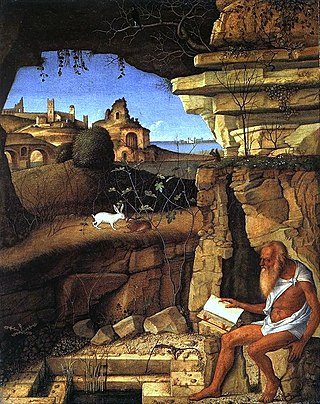
St. Jerome in the Desert is a 1505 oil-on-canvas painting by the Italian Renaissance master Giovanni Bellini, now in the National Gallery of Art in Washington. Little remains of the signature on the first rock in the left foreground, but it has been confirmed as genuine during restoration and can be reconstructed as "[Johannes Bellinu]s. 1505". This is problematic, since the work's general style is linked to fashions no later than 1490, whereas Bellini's style of figures and landscapes had already begun to be influenced by Giorgione by 1500, with the backgrounds more fused and unified in terms of atmosphere. The composition makes it more analogous to his earlier works, such as the c. 1480 St. Jerome in the Desert. The Washington work may have been a collaboration, a work completed by a pupil in Bellini's studio or left incomplete and only finished by Bellini himself much later.

St. Jerome in the Desert or St. Jerome Reading in the Desert is a 1480 oil-on-panel painting by the Italian Renaissance master Giovanni Bellini, now in the Uffizi Gallery in Florence as part of the Contini Bonacossi collection, giving it its alternative title of The Contini Bonacossi St. Jerome.

The Pesaro Altarpiece is an oil-on-panel painting by the Italian artist Giovanni Bellini, dated to some time between 1471 and 1483. It is considered one of Bellini's first mature works, though there are doubts on its dating and on who commissioned it. The work's technique is not only an early use of oils but also of blue smalt, a by-product of the glass industry. It had already been used in the Low Countries in Bouts' 1455 The Entombment, but this marked smalt's first use in Italian art, twenty years before Leonardo da Vinci used it in Ludovico il Moro's apartments in Milan in 1492. Bellini also uses the more traditional lapis lazuli and azurite for other blues in the work.

Pietà or The Dead Christ Supported by the Virgin Mary and St John the Evangelist is a c. 1465–1470 tempera-on-panel painting by the Italian Renaissance artist Giovanni Bellini, now in the Pinacoteca di Brera in Milan.
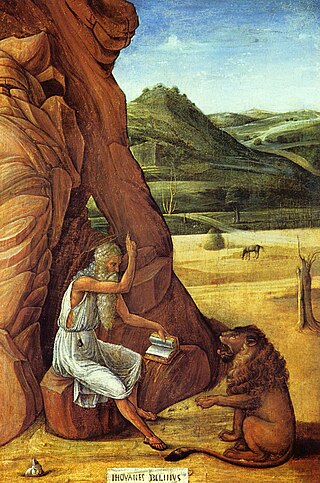
St. Jerome in the Desert is a c. 1450 egg tempera painting on wood by the Italian Renaissance artist Giovanni Bellini, now in the Barber Institute of Fine Arts in Birmingham, England.
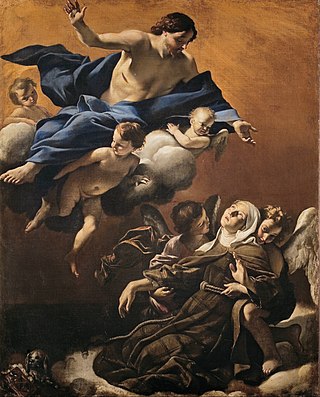
The Ecstasy of St Margaret of Cortona is an oil on canvas painting by the Italian Baroque painter Giovanni Lanfranco, executed in 1622. It is housed in the Palatine Gallery of the Pitti Palace in Florence, Italy.
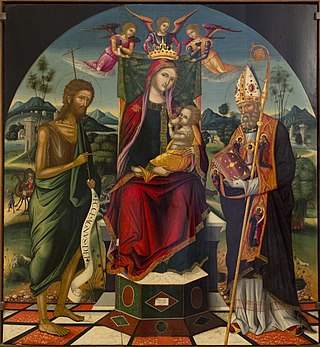
Madonna and Child enthroned with St. John the Baptist and St. Augustine is an oil painting by Greek painter Ioannis Permeniates. He was from Crete living in Venice. He was active during the first part of the 16th century. There are dozens of works attributed to the artist. He is a cross-over artist who painted in both the maniera greca and the Venetian style. Other similar artists were El Greco and Michael Damaskinos. Ioannis Permeniates's work was influenced by Vittore Carpaccio and Giovanni Bellini. His most notable painting is the Madonna and Child enthroned with St. John the Baptist and St. Augustine. Many Italian artists painted the same subject matter. The most famous painting depicting the subjects is the Madonna and Child with St John the Baptist and St Augustine by Petrus Perusinus. The Permeniates is part of the collection Museo Correr in Venice, Italy.
